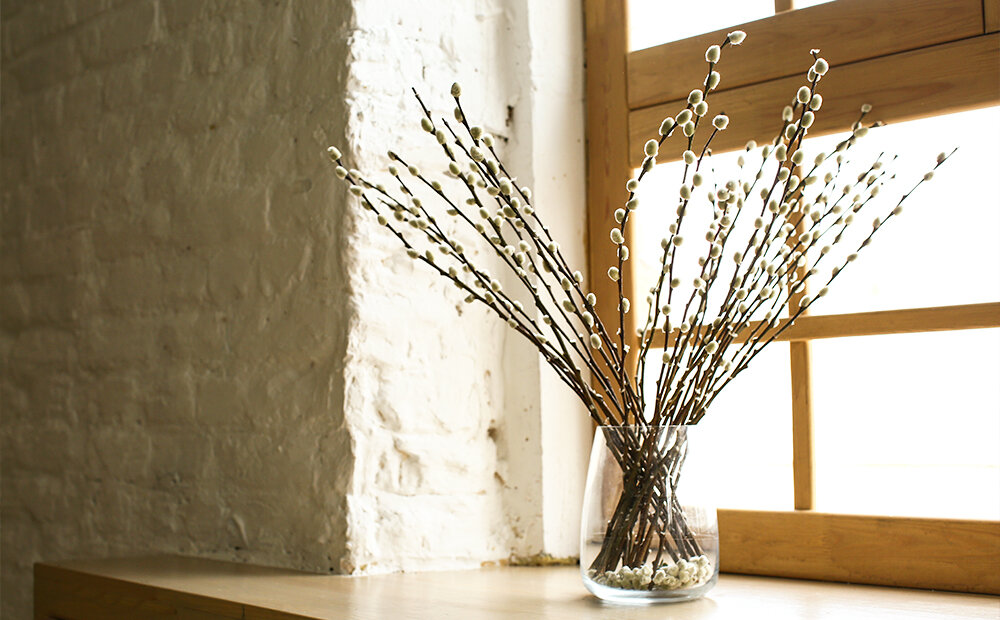HOW TO FORCE SPRING BRANCHES TO BLOOM INDOORS
If you’re getting a little impatient waiting for spring to bring out the blossoms and leaves, take heart! You can get spring to start a little earlier inside your home, and tackle your shrub pruning, all at once.
With a little work, you can force flowering branches to bloom indoors! By pruning off some limbs from your favorite spring-flowering shrubs and forcing them to bloom indoors, you can enjoy their beautiful flowers a little earlier, and for a little longer.
WHEN TO BRING SPRING BRANCHES INSIDE
Spring-flowering shrubs set their buds once they’ve finished blooming in the summer. They do need a few weeks of winter cold to be fully ready to bloom, but usually, by mid-January, they’ve had long enough and can start being brought in for blooming indoors.
Buds can take from 1 to 5 weeks to open indoors, the closer they are to blooming outdoors, the less time you’ll have to wait when you bring them inside.
CHOOSING BRANCHES FOR INDOOR FORCING
When choosing branches, keep good pruning practices in mind. It’s best to make your cuttings when the weather is still cool. Make clean, angled cuts, and choose branches that are crowding others and loaded with buds. While it’s a good idea to remove any damaged or diseased branches, these won’t bloom well. Choose healthy branches and cut them to a length of about 1-2 feet.
In the Indianapolis area, shrubs like Forsythia, Flowering Dogwood, Pussy Willows, Honeysuckle, Crabapple, Magnolia, and Redbud work exceptionally well for indoor forcing. Boxwood, while its blooms are not particularly showy, does have a delightful fragrance. For a multi-sensory bouquet, you may want to pair a few branches of Boxwood with a sprig of a showier flowering species!
FORCING BRANCHES TO BLOOM INDOORS
Transition your shrubs indoors slowly. Place them in cold, fresh water immediately after cutting, and store them overnight in a location on the cool side, like an unheated garage or entryway. Then, bring them indoors and make fresh cuts on a 45º angle at the end of each stem. Crushing the cut area a little bit, and scraping off about an inch of bark around the bottom, will help them to absorb water more efficiently.
Next, place the bottom 2-3 inches of the stems straight into boiling water for about 10 minutes. Scalding the stems of shrub branches helps to seal in their sap, prolonging their vase-life. Without scalding, the sap will flow out into the water fairly quickly, and they’ll fade sooner than necessary.
After you’ve scalded the ends, place your branches in a vase of cool water in a bright location. Keep the water fresh, changing it out every couple of days. Your branches will also benefit from some nutrients and bacteria control. You can use commercial flower food, like the packets that come with cut-flower bouquets, or you can make your own. Add ½ teaspoon of household bleach and 1 cup of 7-Up to 1 quart of water. Using this mixture provides your blooming branches with the nutrients they need to bloom beautifully and slows the growth of bacteria in the water. You can mix this a few days in advance and keep it in the fridge for up to 5 days.
Keep an eye on your branches; some of them may start to develop roots after a few weeks. After they’ve finished blooming, you can cut these branches back to about 6 inches tall, and add new flowering shrubs to your yard!
Ready to start forcing some blooming branches in your home? Stop by our garden center in Indianapolis; we’ve got a variety of pruners and flower foods, and we can offer some tips on when and how to prune a few branches from your shrubs.





